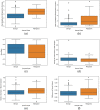Automated vascular analysis of breast thermograms with interpretable features
- PMID: 35937560
- PMCID: PMC9350687
- DOI: 10.1117/1.JMI.9.4.044502
Automated vascular analysis of breast thermograms with interpretable features
Abstract
Purpose: Vascular changes are observed from initial stages of breast cancer, and monitoring of vessel structures helps in early detection of malignancies. In recent years, thermal imaging is being evaluated as a low-cost imaging modality to visualize and analyze early vascularity. However, visual inspection of thermal vascularity is challenging and subjective. Therefore, there is a need for automated techniques to assist physicians in visualization and interpretation of vascularity by marking the vessel structures and by providing quantified qualitative parameters that helps in malignancy classification Approach: In the literature, there are very few approaches for vascular analysis and classification of breast thermal images using interpretable vascular features. One major challenge is the automated detection of breast vascularity due to diffused vessel boundaries. We first propose a deep learning-based semantic segmentation approach that generates heatmaps of vessel structures from two-dimensional breast thermal images for quantitative assessment of breast vascularity. Second, we extract interpretable vascular parameters and propose a classifier to predict likelihood of breast cancer purely from the extracted vascular parameters. Results: The results of the cancer classifier were validated using an independent clinical dataset consisting of 258 participants. The results were encouraging as the proposed approach segmented vessels well and gave a good classification performance with area under receiver operating characteristic curve of 0.85 with the proposed vascularity parameters. Conclusions: The detected vasculature and its associated high classification performance show the utility of the proposed approach in interpretation of breast vascularity.
Keywords: breast cancer; deep learning; malignancy classification; thermal imaging; vessel features; vessel segmentation.
© 2022 Society of Photo-Optical Instrumentation Engineers (SPIE).
Figures






